Future Proofing
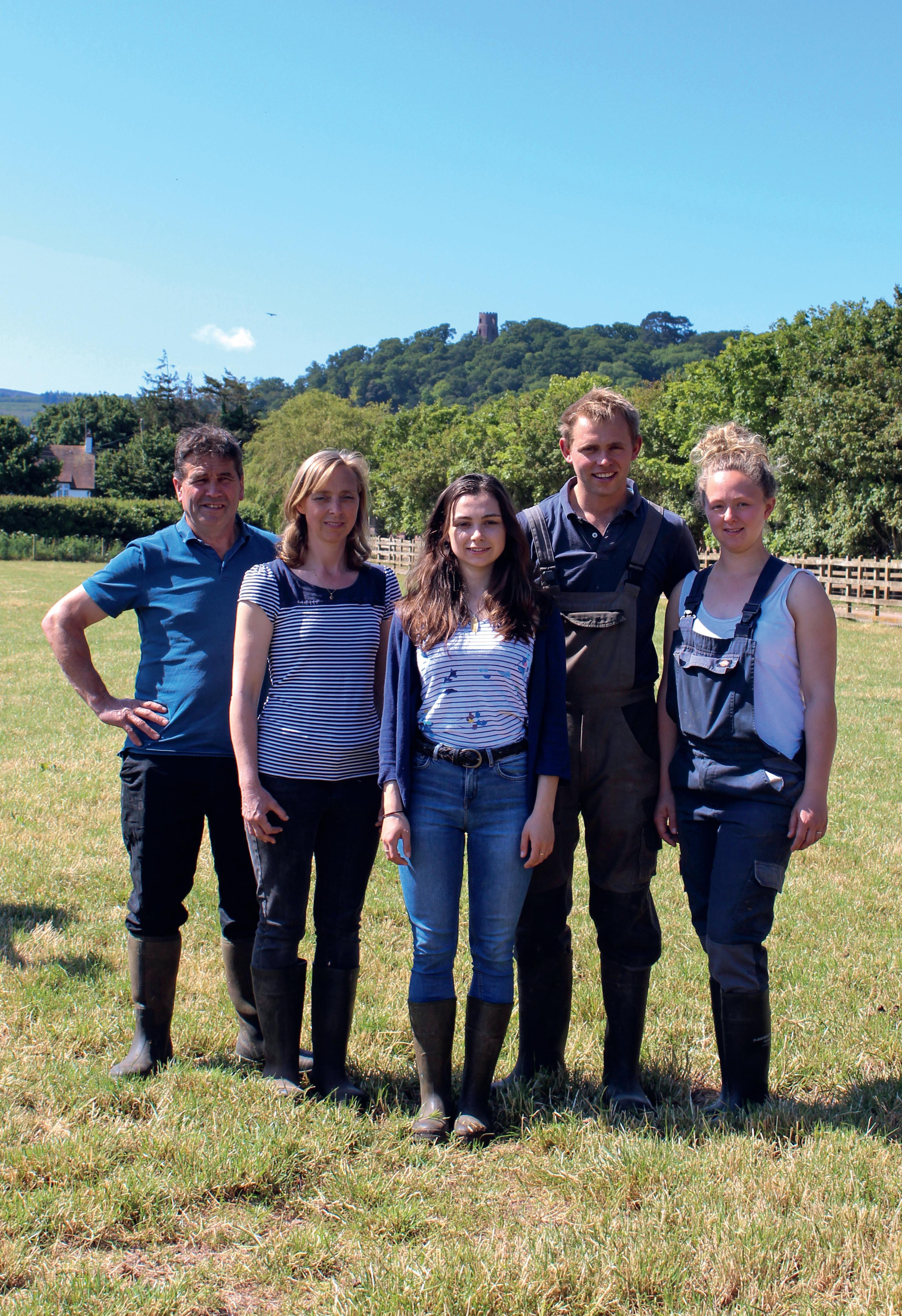
Milking robots secure family farm
Making the most of grass on robots
Bright farming is yours by choice.



Milking robots secure family farm
Making the most of grass on robots
Bright farming is yours by choice.

It’s hard to believe that Lely Center Yeovil is now in its tenth year supporting farmers across the South and South West.
Over the last decade, we’ve evolved into a leading company for the design, supply and installation of automated milking and feeding systems and barn products.
Our ultimate aim is to help our customers reduce labour requirements on their farms, increase productivity and financial wellbeing.
Everything we do is underpinned by the very best customer care, which was recognised at The Cream Awards last year when we won The Dairy Team of the Year.
Our specialist team will help guide you every step of the way, from identifying
the best technology for your farm, through to project co-ordination, barn design and farm management support. We also have 11 professionally certified technicians located throughout our area to ensure local support and backup, 24/7.
In this booklet you’ll hear direct from our farmer customers about how they are benefiting from our technology and support. We’re also offering 0% finance over two years on selected products until the end of the year.
Hopefully we will get to see some of you at The Dairy Show on 7 October. In the meantime, best wishes to your families and stay healthy!

Building a business for future generations and utilising data to fine-tune management have been some of the benefits of adopting a robotic milking system at Lower Marsh Farm, Dunster.
Andy and Judith Fewings were the first farmers to purchase a Lely Astronaut from Lely Center Yeovil when it opened in 2010. Those two A3 robots are still in operation and have clocked up over a million milkings between them. An additional A4 model has since been installed.
Succession was at the heart of the decision to move to robotic milking, with the Fewings keen to create a business that their children would want to get involved in. A robotic system would remove the ties of twice a day milking and bring yield benefits associated with three times a day milking, without the additional labour.
Andy explains: “I have three children. Two were deciding on careers. I wanted to make the dairy farm a more attractive career if they wanted to do it. That was my main reason for putting them in. My son, Scott is now home and he likes the technology.”
not all been down to milking frequency. Andy believes the additional data available through the robots helps make informed management decisions which benefit health and performance.
“You get a health report on the robots which has got better and better over the years. It’s like artificial intelligence. If she’s got really high milk fat and low protein it will predict that she’s milking off her back and will flag up she’s at risk of ketosis,” he explains.
This means propylene glycol can be automatically targeted to these cows through the robot.
“Ian Tossell is passionate and dedicated to the job. He lives and breathes it. Lely do a great job.” Andy Fewings, Lower Marsh Farm, Dunster.
The automatic weigh cells on the robot have also proved valuable. “Stats on the robot tell you when she’s got back to her calving weight and that’s a guide to how well you’re transitioning your cows,” Andy explains.
Weight loss also aids AI decisions. If a cow is back to calving weight at 55 days calved this is a good indication she will hold and is eligible for sexed semen.
Moving to a robotic milking system has made the dairy business at Lower Marsh Farm attractive for future generations. L-r: Andy, Judith, Chloe, Scott and Sophie Fewings.
The 180 cow herd averages 3.1-3.2 visits to the robot each day which has enabled the farm to achieve yields of over 12,000 litres - up from 9,000 litres on twice a day milking. However, it’s
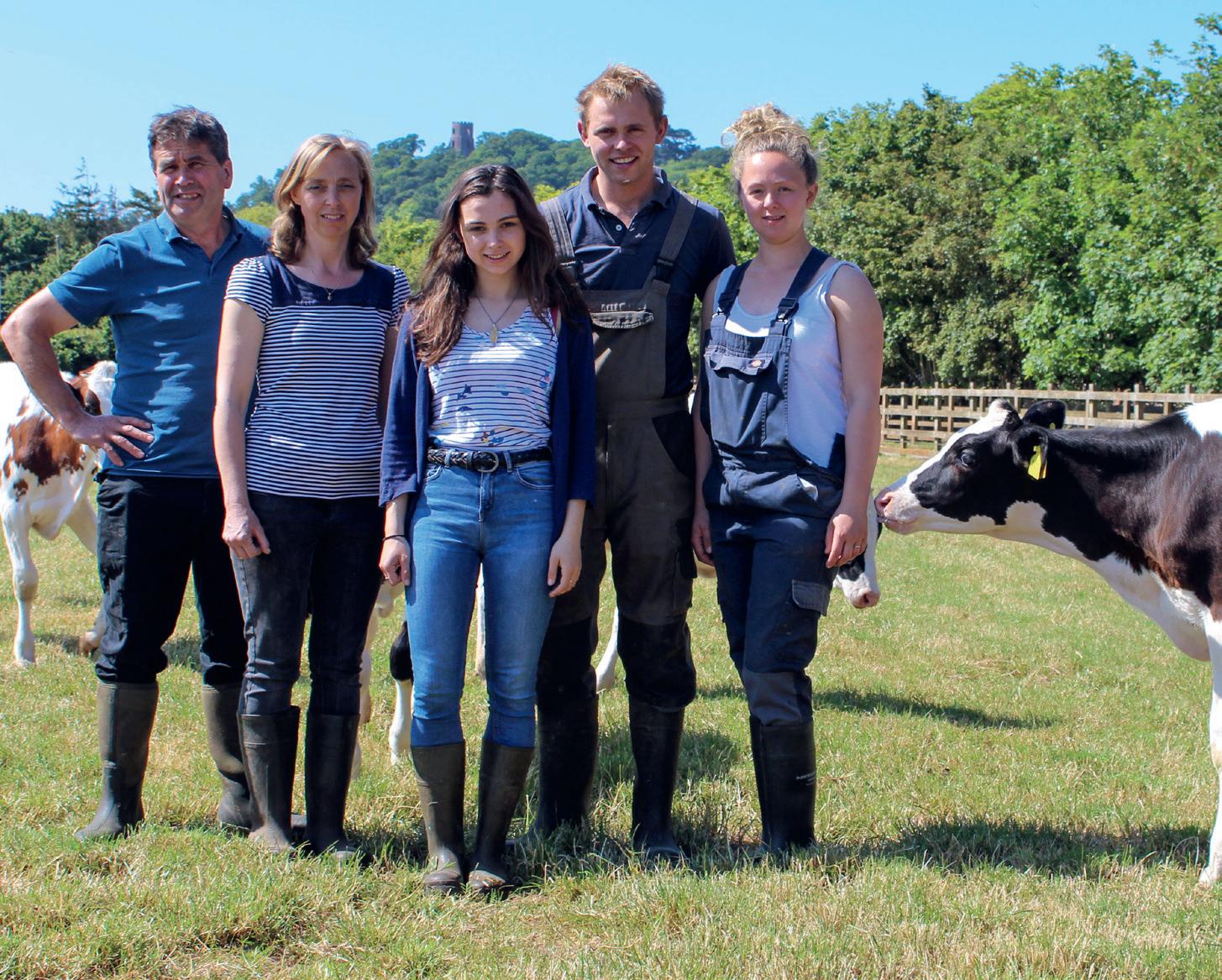
All-in-all Andy believes the robotic system puts the business in a much stronger position. “I think by taking advantage of the data available, it makes you more efficient. If you’re more efficient, you’re more likely to be resilient,” he says.
• Lower Marsh Farm, Dunster, Minehead (tenanted).
• Run by Andy and Judith Fewings and son Scott.
• 180 cows.
• 12,000 litres at 3.9% fat and 3.25% protein.
• 3,900 litres from forage.
• 150-160,000 cells/ml somatic cell count. Bactoscans of 10-12.
• 33-34 cases of mastitis per 100 cows.
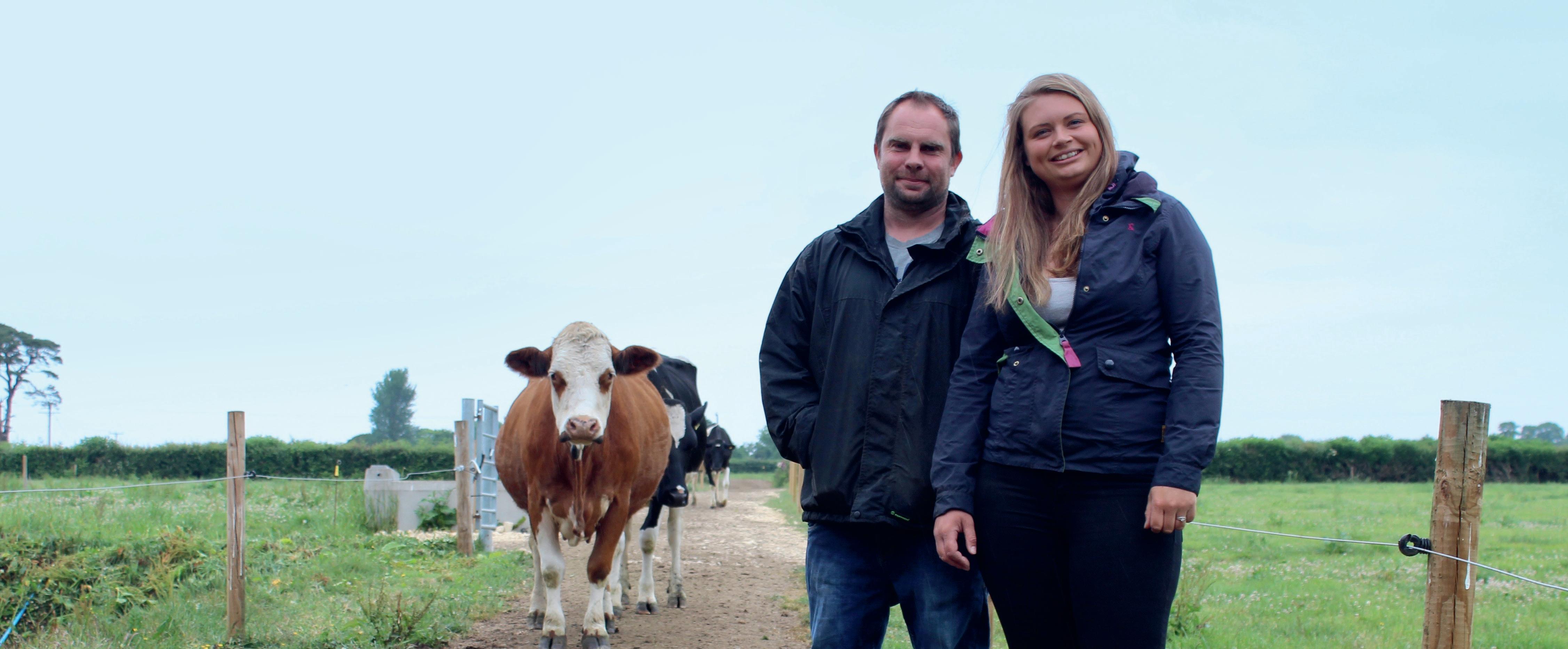
Combining milking robots with a grazing gate has given Donald and Rachael Tolley access to data to help eliminate antibiotic use, all whilst making the most of grass on their organic system.
The Tolleys run 120 cows at Holditch Court Farm, Dorset, supplying antibiotic free milk to OMSCO for export to the US as cheese. The herd is grazed for around eight months of the year.
Rachael admits to being sceptical about whether robots would suit their grass-based system, but two years after moving cows to their green field site, and she’s a firm convert.
“Lely Center Yeovil has especially good back-up. They’re exceptional and always there to help.”
Rachael
Tolley, Holditch Court Farm, Dorset.
“It’s absolutely incredible. We certainly wouldn’t go back now,” says Rachael, who used to milk the herd through a herringbone parlour. “How you can train animals to be individuals is incredible. They’re free range cows. They can always do what they want.”
The herd is milked through two free access Lely A5 Astronauts. Cows can then choose to stay in the barn or go out to grass through the Lely Grazeway gate. The Tolleys operate a ABC grazing system with three, eight hour blocks of grazing. Depending on time of day, the Grazeway will automatically draft cows one of three ways towards pasture. Cows tend to learn when the gate changes to send them to a new block and head back to the gate.
If a cow is eligible to be milked, she’ll be drafted back to the shed or if she’s eligible to graze, back towards the new block. Rachael believes the ABC
The Tolleys operate an ABC grazing system with cows automatically drafted towards pasture through a Lely Grazeway gate.
set-up drives robot visits as cows are driven by a desire for fresh grass. She opts for a strip grazing system using a back fence to maintain grass quality.
The individual cow data and automatic health reporting available through the robot has also proved particularly useful and provided the Tolleys with the confidence to sign up to the antibiotic free contract at the end of last year.
“The robots are so accurate with what they tell you and you can address a problem before it arises,” Rachael explains. “We’ve got milk conductivity which is a good indicator of somatic cell count. If a cow gets flagged up on the system, I Uddermint them. It has definitely helped with mastitis as it stops the problem before you can visually see it.”
This is particularly vital as milk from any cow that’s been treated with antibiotics after entering the milking herd cannot be sold.
• Holditch Court Farm, Holditch, Dorset.
• 120 cows - mix of breeds.
• 9,000 litres a cow a year at 4.04% fat and 3.18% protein - up from 6,500 litres when cows were milked through a herringbone.
• 4,000 litres from forage.
• 2.7 robot visits a day.
• 178,000 cells/ml somatic cell counts.
• Bactoscans of 9.
• 6 cases of mastitis per 100 cows.
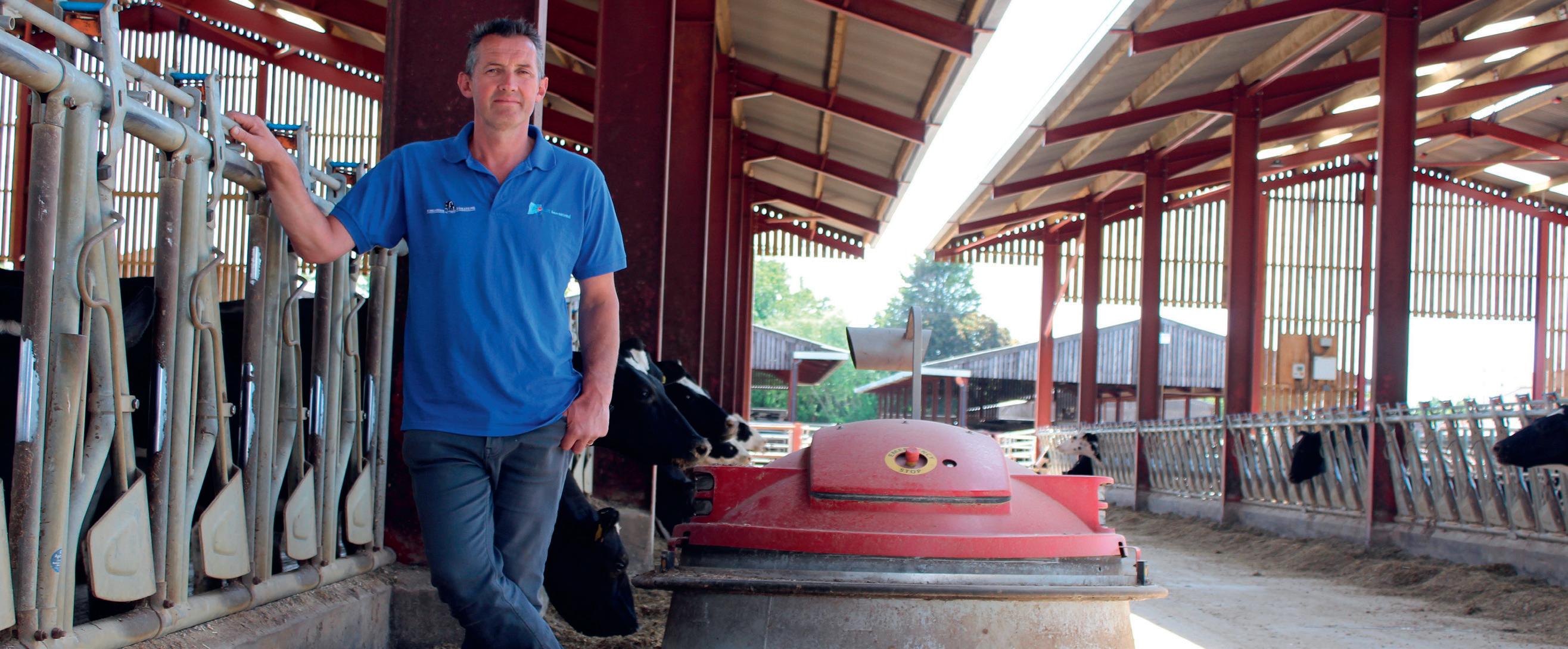
Investing in a second Juno feed pusher is a “no brainer” for the King family who have seen their first robot pay for itself in just over a year thanks to higher feed intakes, yields and less labour.
“There’s many things you can do on farm to improve margins and efficiency and using a robot to push up feed would be at the top of my list,” says Mike King who farms with his brother Chris at Laddenside Farm, Iron Acton.
The Juno robot feed pusher moves automatically along pre-defined routes along the feed fence and around buildings. A rotating mechanism pushes feed back towards the cows. It then returns to a bay for charging.
The Kings had traditionally used tyres on the front of a skid steer loader to push up feed six times a day. However this was time consuming, which prevented them from pushing up more. Subsequently, in 2018 they decide to invest in a Juno to push up feed in a new, 300 cow shed.
“There’s less loss with the Juno than manual pushing up. The Juno is way better than a person on a machine.”
Mike King, Kingspool Holsteins.
At the time they made the most of the small capital grant scheme to fund 50% of the investment. Their half of the investment was paid for in about eight months thanks to a 0.5kgDM/day increase in dry matter intakes and a 0.8 litres a cow day uplift in yields. This has made paying outright for another Juno to service an additional new shed and existing building an easy decision. This will mean that food is pushed up for every cow on the farm, including dry stock.
Eligible for 0% finance over 2 years!
Pushing up feed automatically with the Lely Juno has resulted in a 0.5kgDM/day increase in dry matter intakes, says Mike King.
Mike says: “The new robot will pay for itself in about 15 months based on improved dry matter intakes, yields per cow and time spent pushing grub up on the traditional system. But we haven’t included the reduction in feed losses. There’s less loss with the Juno than manual pushing up. The Juno is way better than a person on a machine.”
The fact feed is pushed up 12 times a day also reduces competition at the feed fence as cows know there is always consistent feed available. This is also helpful on the farm’s once a day feeding system as it prevents sorting. The Juno also acts as a stimulus for cows to get up and eat, encouraging more regular, smaller meals. Mike thinks this helps rumen health and potentially feed efficiencies.
• Kingspool Holsteins, Laddenside Farm, Iron Acton, Gloucestershire.
• Family partnership between brothers Mike & Chris King.
• 2010 RABDF Gold Cup winners.
• 650 cows yielding 12,240 litres a cow a year at 3.78% fat and 3.31% protein.
• 2,545 litres from forage.
• Three times a day milking.
• 140,000 cells/ml somatic cell counts. Bactoscans of 13-14.
• 19 cases of mastitis per 100 cows.
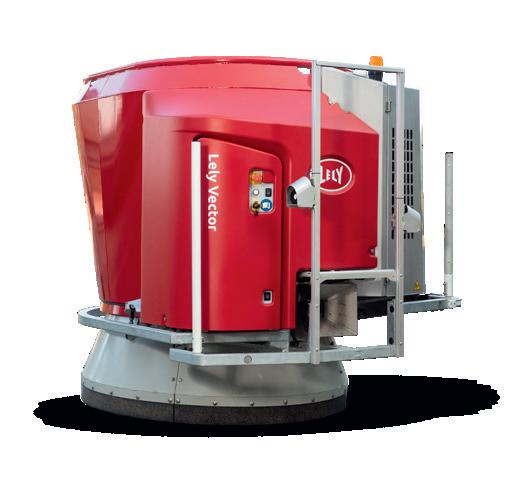
The Lely Vector automatically delivers precise, bespoke rations to individual groups, 24 hours a day, eliminating the need for inefficient, catch-all diets. Used strategically, the Vector increases yields, whilst enhancing cow welfare and improving longevity.
360 Holstein cows, 11,000 litres a cow a year @ 3.8% fat and 3.25% protein, 6 Lely A4 Astronauts.
6-9
different rations automatically fed to different groups of cattle.
£1,000
20 -30 day
hours/week - savings in labour from not having to manually feed out.
a month - savings in concentrate use due to better grouping of low yielders and more targeted feeding.
feed waste has reduced by at least 10% as cows are now fed little and often which reduces the risk of ration heating.
1.7 -10%
the herd’s feed conversion efficiency.
reduction in calving interval since installing the Vector as cows are getting a more consistent diet.
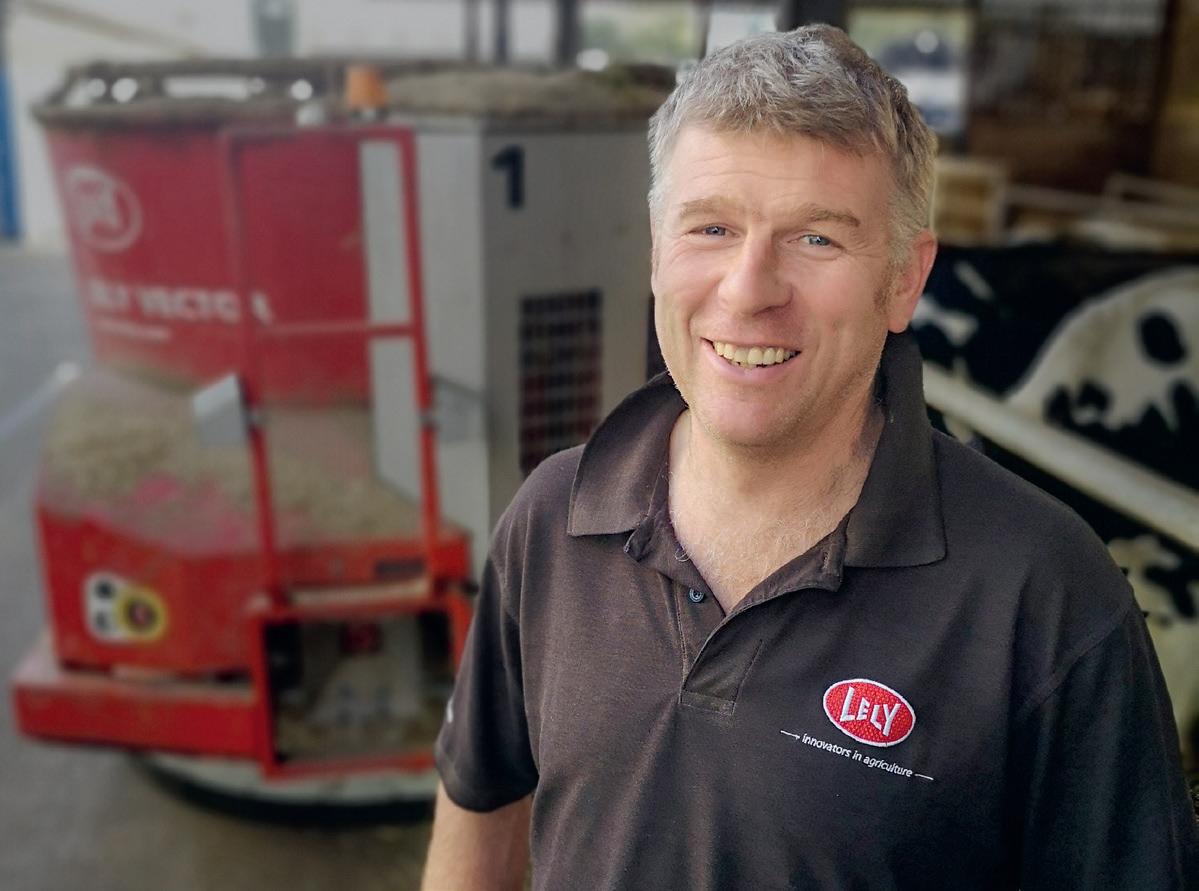
“It’s paid for itself with less labour and more efficient feeding. You’ve got no errors with the feeding; you know exactly what’s going on. The management information you get is really useful - you know all your feed costs, dry matter intakes and feed efficiencies, instantly.”
Andrew Griffiths, Bulls Green Farm, Nantwich.
A robot slurry collector has proved a revelation for Ashley Pulsford who has witnessed improvements in udder health, lameness and labour since it went in 12 months ago.
Prior to installation, Ashley, his uncle David and grandfather Colin spent about two hours a day scraping with a tractor. Narrow passages meant slurry could be up to 4 inches deep at times. This was despite scraping at 10pm at night. Cow cleanliness was subsequently an issue.
As a result, they chose to invest in a Lely Discovery 120 Collector. The robotic system automatically moves around the shed hoovering up slurry as it goes. It then deposits its load in a dedicated pit linked to the slurry lagoon and recharges itself.
The cubicle shed is subsequently dryer and cows are cleaner. Ashley also notes:
The Discovery 120 Collector has saved The Pulsfords two hours a day scraping with a tractor and improved cleanliness, which has helped udder health.
Not having to move cows out of the building to scrape with the tractor has aided lying and feeding times which has benefited production. “Yields are a lot more stable,” says Ashley. “You don’t have bad days. Before, if someone took longer to scrape out one day the milk yield could drop by half a litre a cow per day over the next couple of days. We don’t get that now.”
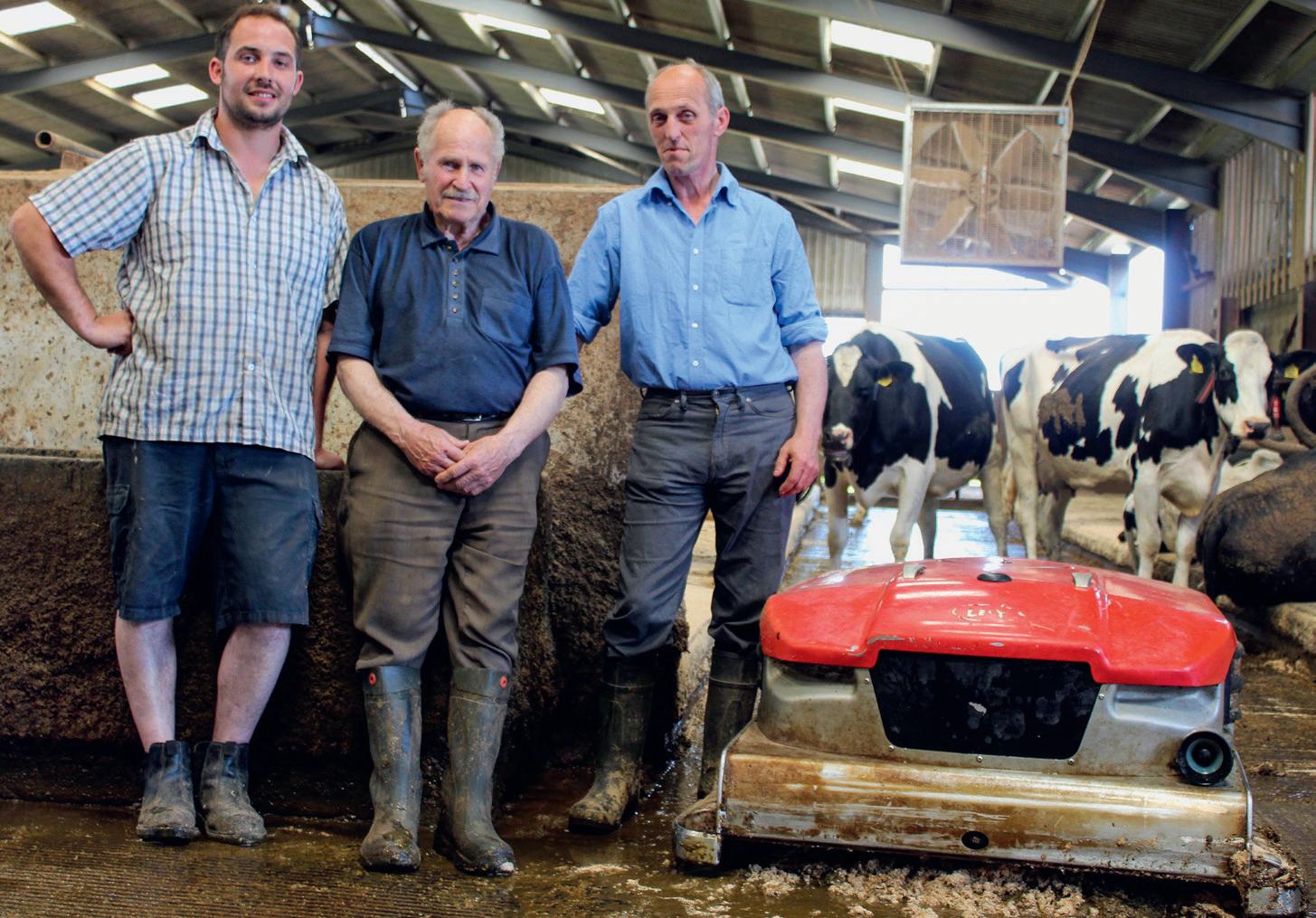
2.
Eligible for 0% finance over 2 years!
“We’ve done a herd health plan and we’ve seen a reduction of five cases per 100 cows in the 12 months since the Collector has been installed. That’s the biggest gain for use by a long way,” says Ashley.
This is largely due to better cow cleanliness which has been reflected in a 20,000 cells/ml drop in average bulk somatic cell counts. Ashely also finds it easier to keep bactoscans on target.
3. Digital dermatitis incidence has halved
“We were struggling with digital dermatitis on their feet and in the cleft of the udder. We see half the cases compared to what we did 12 months ago,” Ashley explains. For example, the foot trimmer reported two cases of digital dermatitis out of 33 cows presented at his last visit. This compares to a previous average of around 7-8 cases.
4. Less antibiotic use
Antibiotic use for lameness and mastitis has reduced. At the same time, the farm is experiencing less Ecoli cases that are typically harder to treat. Cure rates have subsequently improved.
5. Less slipping
The Collector can be set to automatically spray water onto the floor which prevents a slurry film from forming. “We don’t get the slipping and sliding now,” Ashley says. This helps with natural heat expression.
• Sheep House Farm, Camerton, Bath.
• 130 cows yielding 10,711 litres a cow a year at 4.03% fat and 3.31% protein.
• Milked through two Lely A4 robots.
• 3,472 litres a cow a year from forage.
• 143,000 cells/ml somatic cell counts. Bactoscans of 23.
• 6 cases of mastitis per 100 cows.
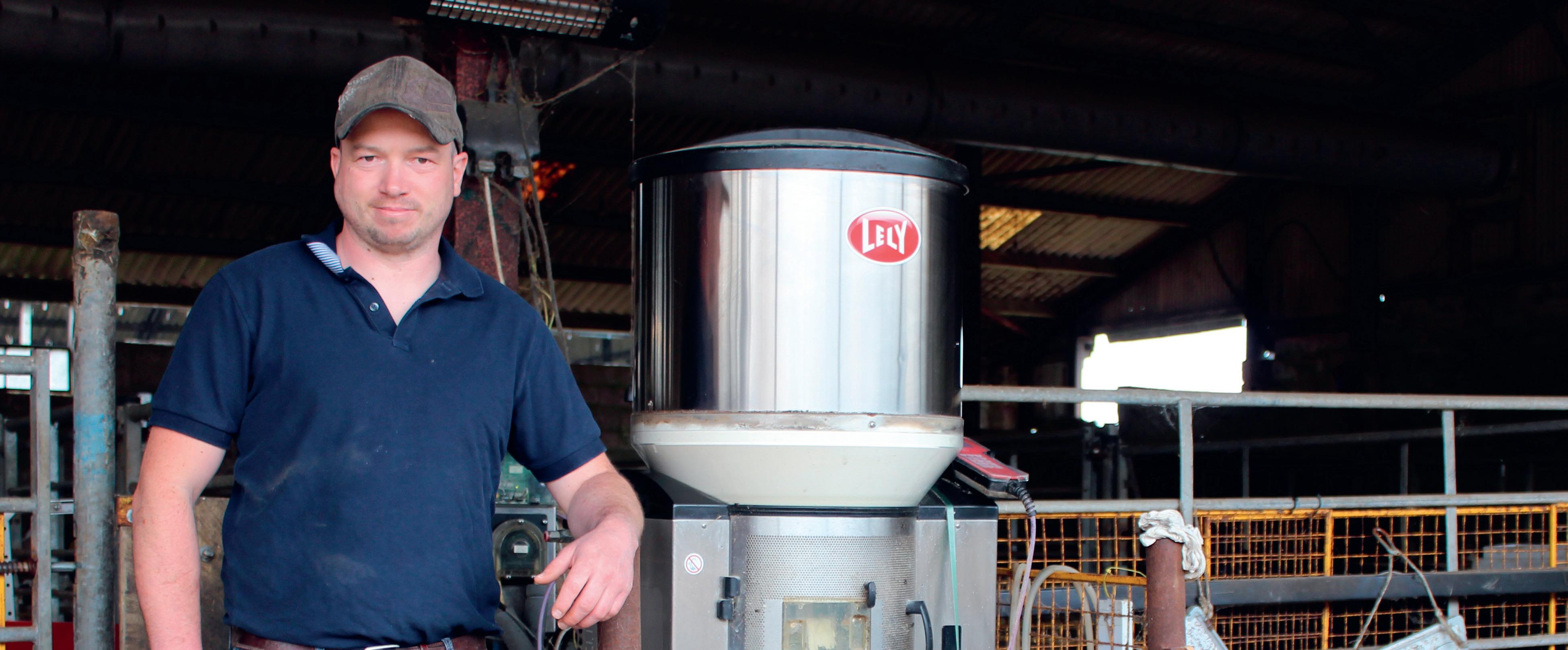
Having traditionally spent around four hours a day manually feeding calves, John was initially drawn to the Lely Calm because of its labour saving potential. Those benefits have been realised, along with many more.
“I reckon it’s saving us at least two hours a day on calf rearing. It makes a big difference and it’s not just time, it’s the flexibility of it. I know I don’t have to feed calves at set times,” explains John who runs 280 Holsteins at Worgret Manor Farm, Wareham.
As milk feeding plans can be tailored to individual calves, feeding efficiencies have improved as beef and dairy calves can be run in the same group, but on different feeding curves.
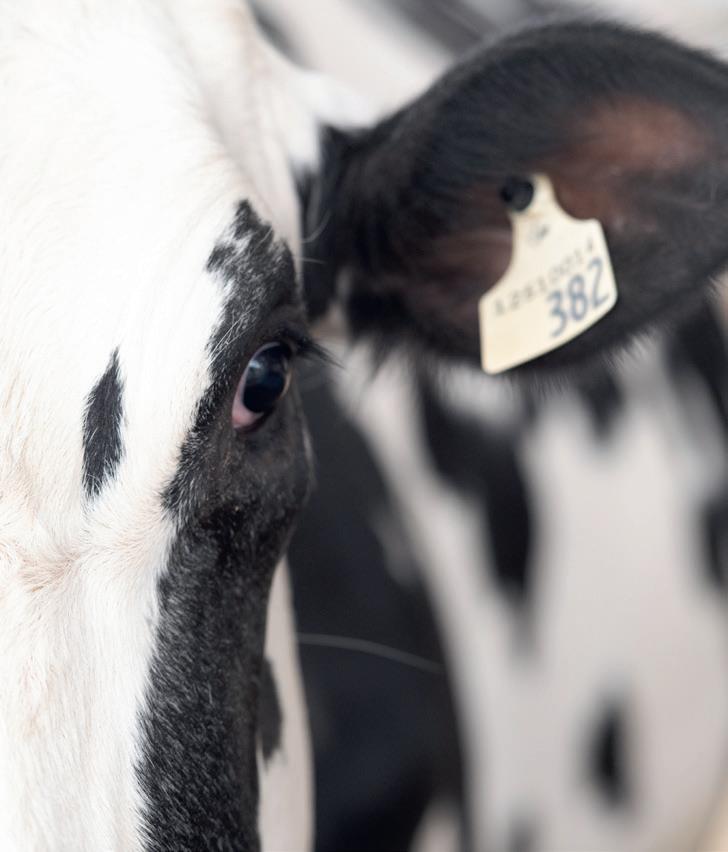
John runs 60 calves on the feeder, split over three feed stations.
“The machine has also allowed us to feed more milk replacer as calves can feed throughout the day in smaller feeds which simulates how they would feed with their mothers,” says John, who believes this also helps calf health.
Calves now receive 1,200g of milk replacer a day, compared to 900g previously. Average pre-weaning growth rates have subsequently increased from 750g/day to 900g/day. An automatic step-weaning process on the machine promotes an efficient weaning off these high milk feeding rates.
John adds: “It’s more efficient for weaning as we can wean on the right date for each calf, rather than as a group.”
